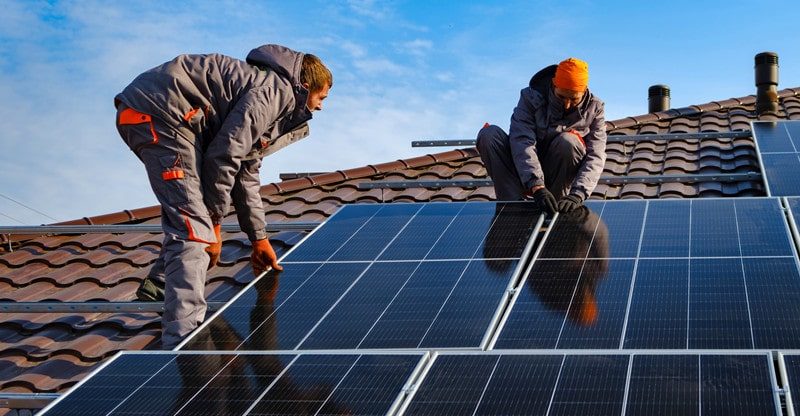Installing Solar Panels: A Comprehensive Guide for Homeowners
Installing solar panels is considered one of the effective methods for combating climate change. As electricity production from fossil fuels is so harmful to the environment, solar panels are a great alternative to your home.
But you might wonder: “How do solar panels work?” and “Do I need an electrician to install solar panels?”
Thankfully, you’ve found the right guide. Here’s everything you need to know about installing solar panels in your home!
How Do Solar Panels Work?
Solar panels, also known as photovoltaic (PV) panels, convert sunlight into electrical energy using the photovoltaic effect. Here’s a simplified explanation of how solar panels work:
Photons Absorption
Solar panels are composed of multiple solar cells made of semiconductor materials, typically crystalline silicon. These materials have properties that allow them to absorb photons, which are particles of light. When sunlight hits the solar panel, the photons transfer their energy to the electrons in the atoms of the semiconductor material.
Electron Excitation
The absorption of photons excites the electrons in the semiconductor material, causing them to break free from their atomic bonds. This creates electron-hole pairs, where the freed electrons become mobile charge carriers, and the positively charged holes are left behind.
Electric Field
Solar panels are designed with a p-n junction, created by doping the semiconductor material with impurities. The n-type region is doped with a material that introduces extra electrons, while the p-type region is doped with a material that introduces electron deficiencies or “holes.” This difference in doping creates an electric field at the junction.
Electron Flow
The electric field at the p-n junction causes the free electrons to move towards the n-type side, attracted by the positive charge of the holes. Simultaneously, the holes move towards the p-type side. This charge carrier migration creates a current flow within the solar cell.
Current Generation
Metal contacts are placed on the surface of the solar cell to capture the moving electrons and holes. These contacts form an electrical circuit through which the current generated by the solar cell can flow. By connecting multiple solar cells in series or parallel, the overall current and voltage output can be increased.
Direct Current (DC) to Alternating Current (AC) Conversion
The electrical energy generated by solar panels is typically in the form of direct current (DC). However, most residential and commercial buildings use alternating current (AC) for their electrical systems. To make the solar energy compatible with the building’s electrical grid, an inverter is used. The inverter converts the DC power from the solar panels into AC power, which can be used directly or fed into the grid.
Power Distribution and Utilization
Electric devices and tools in the house can now be powered by the AC energy that has been changed. Depending on the size of the placement and the amount of sunlight, solar panels can make enough power to meet some or all of a building’s energy needs. With a net metering system, the solar panels can send any extra power back into the grid. This way, the owner can get points or payments for the extra energy.
What Are the Benefits of Solar Panels
There are several benefits of using solar panels as a renewable energy source. Here are five key benefits:
Clean and Renewable Energy
Solar panels generate electricity from the sun’s abundant and renewable energy source. Unlike fossil fuels, solar energy does not produce harmful emissions or contribute to air pollution, making it a clean and sustainable alternative.
Cost Savings on Energy Bills
By harnessing solar energy, homeowners and businesses can significantly reduce their electricity bills. For those looking to further cut down on costs, exploring the cheapest electricity providers can be an added advantage in tandem with solar installations. Solar panels produce electricity that can power various appliances and systems, offsetting the need to purchase electricity from the grid. Over time, this can lead to substantial cost savings, especially in areas with high electricity rates.
Environmental Impact
Solar power is one of the most important ways to reduce greenhouse gas pollution and fight climate change. Solar screens help reduce the use of fossil fuels, which are a major cause of global warming, by turning sunlight into energy. Solar energy also saves water because, unlike standard ways of making electricity, it needs very little or no water to work.
Energy Independence and Security
Solar screens give people a chance to get more energy freedom. When people and groups make their own electricity, they depend less on organized power lines and energy from other countries. This improved energy security can be especially helpful during natural disasters or grid failures since solar panels can still provide power when the grid is down.
Long-Term Investment
Putting up solar panels is an investment that can pay off for a long time. Even though buying and putting the panels cost money upfront, the money saved on energy bills can make up for this cost over time. Solar panels also last for a long time, usually between 25 and 30 years, and they don’t need much care. This makes sure that there will always be power for many years to come.
How Much Do Solar Panels Cost?
The price of solar panels can change based on things like the type and quality of the cells, the size of the system, the cost of solar panel installation, and the area. Prices can also change over time because of changes in the solar business and the market.
For a normal home in the United States, the cost of solar panels, including installation, is between $10,000 and $30,000. This estimate is based on a device that uses between 5 and 10 kilowatts (kW). But it’s important to know that prices can change a lot based on where you live, the unique needs of your work, and any discounts or refunds that may be available.
Where to Get Solar Panels?
When it comes to shopping for solar panels, there are several options available to you. Here are some common places where you can shop for solar panels:
Solar Installers
Local solar installers or contractors specialize in designing and installing solar panel systems. They have expertise in assessing your energy needs, determining the appropriate system size, and selecting the right solar panels for your specific situation. Solar installers can provide personalized advice and recommendations based on your location, energy consumption, and budget.
You can check it out for the best solar panel installers who can guide you through the process.
Online Retailers
Many online retailers specialize in selling the best solar panels, and related equipment. Websites like Solar.com, Wholesale Solar, and Solar Electric Supply offer a wide range of solar panels from different manufacturers. Online shopping allows you to compare prices, read reviews, and access a broader selection of products.
Home Improvement Stores
Major home improvement retailers, such as Home Depot and Lowe’s, often have a solar energy department. They offer a variety of solar panels and related equipment for residential use. Visiting these stores can give you an opportunity to see the products in person and get advice from knowledgeable staff.
Solar Co-Ops or Group Purchases
In some areas, community-based solar co-ops or group purchasing programs are available. These initiatives bring together a group of homeowners interested in solar panels to leverage their collective buying power. By participating in a solar co-op, you can often get discounted prices on solar panels and installation services.
How to Maintain Solar Panels?
Maintaining solar panels is important to ensure they continue to generate electricity efficiently. Here are some general tips on how to maintain solar panels:
Regular Cleaning
Clean the solar panels periodically to remove dust, dirt, leaves, or any other debris that may accumulate on the surface. This can be done using a soft brush, a squeegee, or a hose with a gentle stream of water. Avoid using abrasive materials or high-pressure water, as they may damage the panels.
Inspect for Damage
Regularly inspect the panels for any signs of damage, such as cracks, hot spots, or loose connections. If you notice any issues, contact a qualified solar technician to assess and repair them.
Check for Shading
Ensure that there are no obstructions, such as trees or buildings, casting shadows on the solar panels. Shading can significantly reduce the panel’s efficiency, so trim any nearby trees or adjust the panel’s positioning if necessary.
Monitor Performance
Keep track of the solar panel system’s performance by monitoring the energy production regularly. Most solar inverters have built-in monitoring systems or online portals where you can check the system’s output. If you notice a significant decrease in performance, it could indicate a problem that requires attention.
Be Mindful of Weather Conditions
Solar panels are designed to withstand various weather conditions, including rain, snow, and hail. However, extreme weather events can sometimes cause damage. If you live in an area prone to severe weather, such as hailstorms, it’s a good idea to have your panels inspected afterward to ensure they are undamaged.
Brighten Your World by Installing Solar Panels
Installing solar panels at home may seem intimidating at first, but this comprehensive guide for homeowners breaks down the process. From researching the options, performing cost/benefit analyses, and hiring qualified contractors, this guide has provided homeowners with the steps necessary to make the switch to solar power. So, dive in and start your solar journey now!
Did you learn something new from this article? If so, be sure to check out our blog for more educational content.



